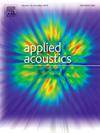Causality-inspired robust low-frequency broadband underwater sound absorption
IF 3.4
2区 物理与天体物理
Q1 ACOUSTICS
引用次数: 0
Abstract
The dynamic properties of viscoelastic damping material are unstable and unpredictable, restricting its applications in underwater sound absorption. This paper investigates a novel causality-inspired design strategy for viscoelastic damping material enhanced underwater absorbers. This design strategy leads to low-frequency broadband absorption spectrum robust to material and geometric parameter uncertain variation. The causality-inspired robust sound absorption for passive system is first demonstrated. Based on this, an optimization strategy in the face of viscoelastic dynamic parameter variation is put forward. The design strategy is further implemented to the viscous damping material enhanced Helmholtz resonator (VDME-HR) to formulate a robust underwater low-frequency sound absorption. A lumped element method based on linearization is applied to predict the power and sound absorption characteristics of the VDME-HR. Results show that the theoretical predictions agree well with the numerical simulations. The experiment verifies the robustness of the design with a mean absorption coefficient at 0.86 in the frequency range [500 Hz, 900 Hz], even when the viscoelastic dynamic parameter varies by four times. This innovative robust design strategy has great potential in the future of noise control.

因果关系激发的稳健低频宽带水下吸声
粘弹性阻尼材料的动态特性不稳定、不可预测,限制了其在水声吸收中的应用。研究了一种基于因果启发的粘弹性阻尼材料增强水下吸波器设计策略。这种设计策略使得低频宽带吸收光谱对材料和几何参数的不确定性变化具有鲁棒性。首次论证了被动系统的因果性鲁棒吸声。在此基础上,提出了面对粘弹性动力参数变化的优化策略。将该设计策略进一步应用于粘性阻尼材料增强型亥姆霍兹谐振器(VDME-HR)上,形成了一种鲁棒的水下低频吸声器。采用基于线性化的集总元法预测了VDME-HR的功率特性和吸声特性。结果表明,理论预测与数值模拟结果吻合较好。实验验证了该设计的鲁棒性,在[500 Hz, 900 Hz]频率范围内,即使粘弹性动力学参数变化4倍,平均吸收系数为0.86。这种创新的稳健设计策略在未来的噪声控制中具有巨大的潜力。
本文章由计算机程序翻译,如有差异,请以英文原文为准。
求助全文
约1分钟内获得全文
求助全文
来源期刊

Applied Acoustics
物理-声学
CiteScore
7.40
自引率
11.80%
发文量
618
审稿时长
7.5 months
期刊介绍:
Since its launch in 1968, Applied Acoustics has been publishing high quality research papers providing state-of-the-art coverage of research findings for engineers and scientists involved in applications of acoustics in the widest sense.
Applied Acoustics looks not only at recent developments in the understanding of acoustics but also at ways of exploiting that understanding. The Journal aims to encourage the exchange of practical experience through publication and in so doing creates a fund of technological information that can be used for solving related problems. The presentation of information in graphical or tabular form is especially encouraged. If a report of a mathematical development is a necessary part of a paper it is important to ensure that it is there only as an integral part of a practical solution to a problem and is supported by data. Applied Acoustics encourages the exchange of practical experience in the following ways: • Complete Papers • Short Technical Notes • Review Articles; and thereby provides a wealth of technological information that can be used to solve related problems.
Manuscripts that address all fields of applications of acoustics ranging from medicine and NDT to the environment and buildings are welcome.
 求助内容:
求助内容: 应助结果提醒方式:
应助结果提醒方式:


